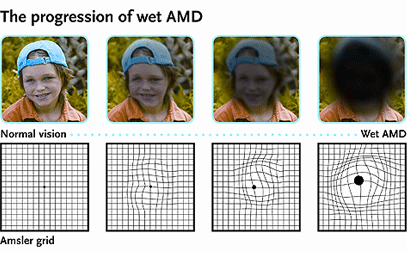Target Indication
Eye diseases of the retina is the leading cause of blindness in the western world
Wet age related macular degeneration afflicts over 1.5% of people over the age of 50. Untreated, vision will deteriorate rapidly. Current treatments require regular intra-ocular injections.
Ophthalmology – wAMD and DMO
Wet Age-Related Macular Degeneration (wAMD) is a neovascular disease of the retina, which means that blood vessel growth is upregulated (increased) in the back of the eye, in a process largely driven by VEGF. In wAMD, the growth of new vasculature through from the choroid ruptures the Bruch’s membrane and causes disruption to the usually uniform layer of photoreceptive cells responsible for vision. This initially presents as a central blurriness which eventually progresses to a complete loss of central vision. Wet AMD affects more than 170 million people worldwide and is expected to increase to almost 300 million people in an ageing population, making wAMD the leading cause of blindness in the developed world. These patients, if untreated, are likely to lose sight in the affected eye within 24 months of onset.
Diabetic Macular Odema (DMO) is the build-up of fluid (Oedema) in a region of the retina called the macula. The macula is important for the sharp, straight-ahead vision that is used for reading, recognising faces, and driving. Diabetes affects almost 400 million people globally, and this number is estimated to double by 2040, and a third of those affected display signs of diabetic retinopathy – defined as leakiness and proliferation of blood vessels in the retina. About half of all people with diabetic retinopathy will develop DMO and although it is more likely to occur as diabetic retinopathy worsens, DMO can occur at any stage of the disease.


Current Therapies
Current therapies for neovascular eye diseases target all isoforms of VEGF. Drugs which inhibit VEGF and its receptors are already the standard of care for a number of diseases, including wAMD, and they are also a mainstay of cancer therapy treatments across multiple tumour types. This is due to the role VEGF plays as a key driver in the formation of new blood vessels.
However non-specific inhibition of VEGF is associated with limited efficacy, resistance, off-target effects and toxicity. Current universal VEGF inhibitors like Lucentis® are expensive, they improve vision in less than 40% of patients and must be injected directly into the eye once a month. Additionally, intraocular injections carry their own risks, including ocular hypertension, endophthalmitis, and retinal detachment. Both patients and clinicians are averse to this form of administration, but current attempts to improve this course of treatment only focus on reducing the injection frequency through the development of depot delivery systems.
Our aim is to remove the need for injections entirely by developing formulations that can be administered as topical eye drops, offering substantially improved quality of life for patients and at a much lower cost to administer. We aim to specifically target the pathological blood vessel growth that underlies the progression to blindness. We will do this by reducing the angiogenic VEGF isoforms which are upregulated in wAMD, without inhibiting the beneficial, non-pathological VEGF isoforms. As a result, Exonate’s molecules will potentially be associated with fewer off-target effects, lower toxicity levels and improved safety profiles. (Read more about how they work here.)